Hey, its even Arrest Me Red. Cool pick-up! Best wishes Beaus67
When did Ford start painting 200 head's red again?
My 1966 200 is red,
the last 200 low mount from an x-shell Granada was black.
my mates 81 low mount is grey,
my 1982 Mustang is blue
ah who cares, just go for it, it lookes like its been given some tlc, so should be good...
When did Ford start painting 200 head's red again?
My 1966 200 is red,
the last 200 low mount from an x-shell Granada was black.
my mates 81 low mount is grey,
my 1982 Mustang is blue
ah who cares, just go for it, it lookes like its been given some tlc, so should be good...



 Yeah, Bill, that's great ( 599X148 ) for those of us who aint seen 1. Glad U labeled it, cept 4 the simeesed 3rd & 4th I don't believe I would a recognized it! (when they called it "hex" head) or is dat a diff'rent 3rd one 2? (where's the dunce smilie when I need it?)
Yeah, Bill, that's great ( 599X148 ) for those of us who aint seen 1. Glad U labeled it, cept 4 the simeesed 3rd & 4th I don't believe I would a recognized it! (when they called it "hex" head) or is dat a diff'rent 3rd one 2? (where's the dunce smilie when I need it?)